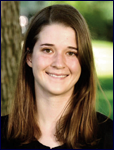|
 University of Kansas - Research Experience for Undergraduates - June 1 - July 29, 2106 University of Kansas - Research Experience for Undergraduates - June 1 - July 29, 2106 |
CReSIS Sponsored REU/RET Students
Introductory Flyer from KU can be found HERE >>>>
2016 KU Student Handbook >>>>>>
Professional Development Seminars >>>>>>
KU Summer UR Events >>>>>> |

Full Paper - Word/PDF |
AUDREY EVANS
SR - ENGPHY - University of Kansas

Title: Implementation of Power Divider for 2-18-GHz Vivaldi Antenna Array
Abstract: Lightweight radar systems are critical for load utilization of small unmanned aircraft. This communication presents the proposed design of a 2-18-GHz ultra-wideband Vivaldi antenna array that employs a power dividing chip in order to reduce the antenna’s weight and size. Previous designs use a Wilkinson power splitter that requires a cascade of resistors over a large surface area in order to divide power evenly to all 16 elements. The power dividing chip replaces the larger Wilkinson splitter while using a smaller footprint in the layout of the antenna. The 16-element antenna array will enable airborne radar measurements of snow and ice for the Center for Remote Sensing of Ice Sheets (CReSIS).
|

|
Tayla Frizell
SR - MathEd - Mississippi Valley State University
tayla.frizell@mvsu.edu

|
 |
Joselyn Hathaway
SO - MathEd - Elizabeth City State University
jhathaway584@students.ecsu.edu
 |
| Full Paper -Word/PDF |
Title: The Impact of STEM Outreach in Schools and Communities
Abstract: The Center for Remote Sensing of Ice Sheets (CReSIS) at the University of Kansas is a National Science Foundation (NSF) Science and Technology Center (STC) CReSIS’ K-12 Educational Outreach Program with a curriculum designed to introduce students to the dynamics of polar ice sheets and their effects on sea level rise. The Ice, Ice Baby (IIB) curriculum is a series of inquiry-based lessons developed by CReSIS K-12 Educational Outreach Staff and consists of 7 units with 31 lesson plans. Data (pre- and post-surveys from students and teachers) from the IIB program has been collected and assessed annually. This research study focuses on the impact the IIB curriculum has made on student participants in the program, their level of interests in STEM, and will examine data assessed from the student and teacher surveys from 2010 to 2015. Science, Technology, Engineering, and Mathematics (STEM) outreach programs target K-12 students and enhance student learning, comprehension skills, and helps students understand various principles related to STEM [10]. These programs are coordinated by various organizations, colleges, or universities that are staffed with STEM professionals and facilitators [4]. A major issue that schools face today is the low involvement of minority students in STEM education and careers. Research suggests ways to get students involved includes: developing discussions, hands-on activities, and incorporating STEM into lesson plans [6]. The research presented will support the effectiveness of STEM outreach programs, explain how they are essential to student learning, and the importance of encouraging students to participate in STEM. |

Full Paper - Word/PDF |
Megan Metz
University of Kansas
megan.metz@ku.edu

Title: Image Processing Techniques and the Role of Temperature in Antarctic Firn Stratigraphic Internal Layering
Abstract: Snow radar echograms obtained through an airborne ultra-wideband (UWB) microwave radar have been used to assess annual snow accumulation, climatic anomalies, and spatial patterns by identifying the internal layers that correspond to annual or sub-annual snow accumulation. While this is relatively simple for moderate accumulation regions with approximately 0.3 m water equivalent accumulation per year, the internal layering at low accumulation sites is often closely packed and more difficult to see while high accumulation sites also contain sub-annual layers associated with individual storms. To improve layer identification, an image processing procedure was developed to increase the contrast between the annual layers. To discriminate between layer types, ice core annual accumulation data were used to identify potential sub-annual layers. This study dated layers within the top 75 m of firn in West Antarctica for several echograms, and identified the time period of strong reflectors (darker layers in the echogram). Meteorological data from a global weather forecast reanalysis model was used to investigate the weather conditions associated with the strong reflectors to explain their cause. |

Full Paper - Word/PDF |
Levi Sedlock
SR - EE - University of Kansas
lsedlock39@gmail.com

Title: Compiling bed topography data along a central flowline of Helheim Glacier
Abstract: The Greenland Ice Sheet contributes roughly xx millimeters of freshwater to the ocean each year through surface melt and ice mass loss. As climate warms, the amount of freshwater discharged to the ocean has more than doubled. Helheim Glacier in southeast Greenland is a particularly important glacier because it is one of the largest outlet glaciers in Greenland and has undergone a wide range of changes in the past 35 years. From 2003 to 2005, Helheim Glacier underwent large-scale acceleration, retreat and thinning [1]; since 2005, the glacier has been much more stable. The large variability in ice mass discharge over short time periods makes Helheim Glacier a critical glacier to model for sea level rise projections. Time-varying numerical models are largely based on 1-dimensional parameterizations of glacier characteristics. For Helheim Glacier, a consistent parameterization of the bed topography does not exist; published flowline models of Helheim are often based on different bed geometries. In order to compile a best-estimate of the bed topography along the central flowline, I will use CReSIS airborne radar data from 2001-2009, MATLAB R2014a, the CReSIS toolbox, and the CReSIS Graphical User Interface (GUI) picker tool. Using these tools and datasets, I will produce a database of bed topography along a center flowline of the main branch of Helheim Glacier, southeast Greenland. This flowline data is crucial in assessments, and models predictions of how Helheim Glacier will contribute to sea level rise in the foreseeable future. |

Full Paper - Word/PDF |
Jordan Sprick
SR - EE - University of Kansas
jsprick@ku.edu

Title: 3D Radar Imaging of Canadian Archipelago Glaciers
Abstract: My research will be focused on the creation of a synthetic aperture radar (SAR) simulator. The scripts will predominantly be written and executed in MATLAB and will include some C++ functions in order to improve speed. One of the main advantages of SAR is that it utilizes the motion of its components relative to a target. This relative velocity elicits the Doppler effect, changing the frequency of a signal as a function of its relative velocity. This effect is attractive because it improves a system’s ability to distinguish between multiple targets. Antenna arrays in SARs are used to change the directivity of signals and also assist in differentiating between multiple targets. The interest of my research lies in determining positions of multiple targets utilizing SAR and array processing techniques. In array processing, various effective beamforming techniques are implemented in order to determine parameters of multiple received signals. For the simulator, I will explore and implement the Most Likely Estimator (MLE) and Multiple Signal Classification (MUSIC) techniques. MLE assumes a probabilistic model of the noise accompanying the received signals. Based on this model, MLE aims to select an angle of arrival (AOA) that maximizes the angle likelihood function. MUSIC exploits the orthogonality of the signal and noise subspaces to determine which steering vector (a function of AOA) fits best within the received signal subspace. The simulator should be able to take target parameter inputs (range, AOA, etc.) and output an accurate representation of each method’s parameter estimations. |

Full Paper -Word/PDF |
Joe Vincent
SO - Aerospace - University of Kansas
jowvincentkc@gmail.com

Title: Beamforming Sensitivity of Airborne Distributed Arrays to Flight Tracking and Vehicle Dynamics
Abstract: For remote sensing applications requiring aerial grid surveys, the emergence of small- and medium-class Unmanned Aerial Systems (UAS) as viable and cost-effective platforms offers new opportunities to achieve finer-resolution measurements using Synthetic Aperture Radar (SAR) than their larger, manned counterparts. SAR processing utilizes the forward motion of the vehicle to synthesize a very long antenna, and thus a very narrow-beam in the along-track direction. This same concept can be extended to two-dimensions by flying a series of closely-spaced flight lines (2D SAR), thus enabling the same array beamforming capabilities in the cross-track direction in post-processing as larger-manned aircraft equipped with large-antenna arrays. The implementation of a UAS SAR system has the potential benefits of finer detail sensing, automation dull flight lines, and potential cost reductions compared to conventional SAR. While 2D phased array synthesis using UAS platforms is theoretically possible, there are several challenges that must be addressed before this application can be realized. Small UAS are incredibly sensitive to disturbances during flight, and thus deviate from their nominal flight paths. The resulting positional errors from these disturbances will make it difficult to resolve coherent radiation patterns and minimize sidelobe levels when synthesizing the 2D array. We will identify the beamforming sensitivity of 2D synthesized arrays generated from closely spaced flight tracks to in-flight disturbances that result in perturbations. Array beamwidth and sidelobe level sensitivity to the number of flight-lines (antennas) in the array, spacing between flight-lines, and perturbation in flight path will be assessed using computer-based simulations. |
| |
|
|
